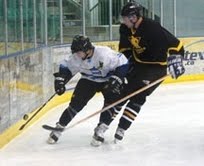 For those of you, who have followed my principles, hopefully you’ve been training throughout most of the off-season. At this point, you should be at a point of tapering, where you’re likely preparing for the season with more on-ice work. If not, you may have put yourself at a deficit. However, there’s still hope!
For those of you, who have followed my principles, hopefully you’ve been training throughout most of the off-season. At this point, you should be at a point of tapering, where you’re likely preparing for the season with more on-ice work. If not, you may have put yourself at a deficit. However, there’s still hope!
Many of you have likely already tried out and hopefully made the team. For the remainder still waiting for tryouts, you can make some significant progress. Even in a short period of time, the body can adapt to be more functionally sound, especially if you have trained in the past and were just lax this off-season.
If you have more than a month, you’re one of the lucky few (if you’re willing to put in the work). You can make some significant strides in changing your endurance capacity through better cardiovascular endurance. Now, I’m not saying you’ll be better than the guys that have trained all off-season (it’s just not likely, but possible). If you focus on doing the right things and become dedicated, then you can benefit. If you are less than two weeks out from tryouts, then you’re at more of a disadvantage. Again, it’s still possible to make some physiological changes even if only slight.
In both instances, the key is to ensure you don’t push yourself toward injury. Your body is going to require rest, so plan accordingly. The last thing you want to do is wind up hurt, resulting in a missed tryout. We can’t work miracles here, but as I mentioned earlier, we can make some adaptations.
Here are my suggestions:
1 Month
3-4 weeks of muscular endurance and cardiovascular output training
This type of training will benefit you in the capacity of decreasing the time it takes to recover between shifts, practices and game. We want your body to be able to utilize all of its energy, as well as recover quickly.
Focus on bike training, including Tabata Protocol, as well as long distance rides. Build yourself up at a pace, that is suitable, yet challenging. Again, no need to push to hard to quickly. Start with maybe 2 miles, then progress to 4, 6, 8, 10, etc. Choose a resistance that is difficult but not exhausting. If you’re tired after a minute of riding, then you should lower the resistance. Include Tabata on Monday and Friday. Work your way up to utilizing Tabata 3-4 times per week. Again, you need recovery. Be sure to do light “flush” rides at a very moderate intensity for 10 minutes.
2 weeks
While you can make some strides in cardiac output, it may not be enough. I’m not suggesting against the above, but I think you would be better suited in focusing on flexibility through Dynamic muscle activation.
Dynamic is all the buzz right now, but for good reason as current research suggests that static stretching pre-game can reduce muscle stiffness. What this means to you is that your muscles will not be able to recruit, fire, and stabilize as efficiently as when using a dynamic type warmup/flexibility training. By increasing flexibility, you are giving yourself the best opportunity to avoid injury, as well as facilitate agility on the ice.
Join up with my friends at HockeyOT for some dynamic videos that can best help you prepare in a short amount of time.
Best of luck in tryouts!
Feel free to contact me with any questions at chris@assistperformance.com
This article was written by hockey training specialist Christopher Costa. Chris’s life has revolved around hockey, as a coach, player and official for 22 years. His training protocols address all key aspects in producing elite talent, as well as nutrition. His passion is to help elite hockey players achieve the highest level of performance. In 2012 he worked with the Philadelphia Flyers organization and is currently pursuing a Master’s degree in Human Performance.















